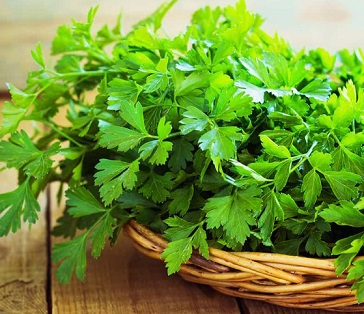Herbs And Phytochemicals: Parsley Emerging As A Potential Source Of Cardioprotective Phytochemicals
Nikhil Prasad Fact checked by:Thailand Medical News Team Feb 29, 2024 1 year, 8 months, 2 days, 16 hours, 54 minutes ago
Herbs And Phytochemicals: Cardiovascular diseases (CVD) continue to pose a significant threat to global health, with an annual death toll of 17.9 million worldwide. Among the myriad contributors to CVD-related mortality are ischemic heart disease, strokes, hypertension, and peripheral arterial disease. In the pursuit of effective preventative measures and therapeutic interventions, researchers are increasingly turning their attention to natural sources, such as herbs and spices. One such herb that has captured scientific interest is Petroselinum crispum (Mill.) Fuss, commonly known as parsley, owing to its rich nutrient content and the presence of bioactive secondary metabolites, particularly the flavone apigenin and its glycosides.
 Parsley Emerging As A Potential Source Of Cardioprotective Phytochemicals
Parsley: A Botanical Overview
Parsley Emerging As A Potential Source Of Cardioprotective Phytochemicals
Parsley: A Botanical Overview
Petroselinum crispum, belonging to the Apiaceae family, is an annual or biennial plant native to Europe and the Mediterranean regions. Widely cultivated for its aromatic edible leaves, parsley finds extensive use in culinary applications, from condiments in sauces and salads to garnishes and flavor enhancers in soups. The plant boasts a nutrient profile rich in vitamins (B1, B2, B3, B5, B6, C, E), minerals, essential oils, and various polyphenol compounds, particularly flavonoids. The chemical composition of parsley is influenced by factors such as growing conditions, cultivars, geographic regions, and plant organs.
Chemical Composition of Parsley Extracts
The chemical composition of parsley extracts, derived from its leaves, aerial parts, and seeds, has been a subject of extensive investigation. Flavonoids, with apigenin as a major aglycone, feature prominently in these extracts. Apiin and malonylapiin, glycosides of apigenin, have been identified as significant compounds. Bioavailability studies in human volunteers have shown the presence of apigenin in plasma and urine after parsley ingestion. Other flavonoids, including glycosides of luteolin, diosmetin, kaempferol, quercetin, and isorhamnetin, along with phenolic acids and coumarins, contribute to the diverse phytochemical profile of parsley.
Parsley and Cardiovascular Health
Herbs And Phytochemicals research over the past two decades has unveiled parsley's potential as a source of cardioprotective agents. Studies in animal models have demonstrated its antithrombotic, antihypertensive, and hypolipidemic properties, all of which are crucial in preventing cardiovascular disorders.
Antithrombotic Activity
Thrombosis, the formation of blood clots in vessels, poses a significant risk for life-threatening events such as myocardial infarction and stroke. In vitro studies have shown that parsley extracts inhibit thrombin and platelet aggregation, demonstrating antiplatelet activity. In vivo studies in rats have further confirmed the ability of parsley to reduce thrombus formation, with apigenin and its derivatives implicated as contributors to this antithrombotic activ
ity. The findings suggest that parsley's antiplatelet effects could be valuable in preventing both arterial and venous thrombosis.
Antihypertensive Activity
Hypertension, a major risk factor for cardiovascular diseases, has been the focus of investigations into parsley's effects on arterial blood pressure. Studies in rats have demonstrated a hypotensive effect following oral administration of parsley seed infusion and leaf decoction. The vasorelaxant activity observed in aortic rings suggests a potential mechanism through the blockade of calcium channels.
Apigenin, present in parsley, has also shown promise in reducing blood pressure and improving vascular function in hypertensive animal models, emphasizing its potential role in parsley's antihypertensive effects.
Hypolipidemic Activity
Dyslipidemias, characterized by abnormal lipid levels, contribute significantly to coronary heart disease and stroke. Parsley extracts, particularly from seeds and leaves, have demonstrated hypolipidemic effects in animal models. Apigenin and its derivatives have also exhibited similar effects, reducing cholesterol levels and improving lipid profiles. The dual action of parsley in managing hyperlipidemia and hyperglycemia, as observed in diabetic rat models, raises the possibility of parsley-based formulations as potential interventions for individuals with both conditions.
Conclusions and Perspectives
Parsley emerges as a promising candidate for the development of herbal formulations aimed at promoting cardiovascular health. Its well-established presence in the global seasonings and spices market makes it an easily accessible plant material. However, challenges such as standardization of extracts, identification of bioactive compounds, and the need for clinical trials remain.
The chemical characterization of parsley, particularly specifying the variety used, is crucial for understanding its varied effects. Apiin and apigenin, identified as significant contributors to parsley's bioactivity, could serve as potential chemical markers for standardized formulations. Bioavailability studies highlight the presence of apigenin metabolites in human plasma and urine, supporting the development of parsley-based products.
Clinical trials represent the next frontier in validating the observed cardioprotective effects of parsley in animal models. Overcoming challenges related to extract standardization, chemical composition, and bioavailability will be essential for advancing parsley-based therapeutic products. In conclusion, parsley stands at the forefront of herbal interventions for cardiovascular health, awaiting further exploration and development.
The study findings by researchers from Universidade Federal do Rio de Janeiro (UFRJ)-Brazil were published in the peer reviewed journal: Nutraceuticals.
https://www.mdpi.com/1661-3821/4/1/8
For the latest on
Herbs And Phytochemicals, keep on logging to Thailand Medical News.
